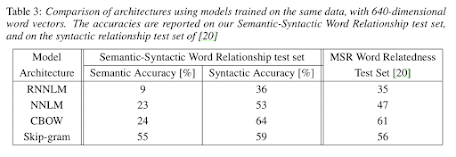Efficient estimation of word representations in vector space (Mikolov et al., 2013)
Introduction
Traditional n-gram model
Principle: prediction of next word based on previous n-1 words; probability of a sentence obtained by multiplying the probability (the n-gram model) of each word
e.g., "This is a puppy"
n = 1 (unigram): [This] [is] [a] [puppy] (this, is, a puppy)
n = 2 (bigram): [This is] [is a] [a sentence] (this is, is a, a sentence)
n = 3 (trigram): [This is a] [is a sentence] (this is a, is a sentence)
Limits:
i. insufficient amount of in-domain data (for ASR)
ii. curse of dimensionality
iii. difficulty of generalization (because the n-gram model has discrete space)
iv. poor performance on word similarity tasks
Distributed representations of words as (continuous) vectors (vs. one-hot encoding)
e.g., queen → | 0.313 | 0.123 | 0.326 | 0.128 | 0.610 | 0.415 | 0.120 |
learning cost(?): the vocabulary size V * the number of parameters m (here 7)
- Previous work on representation of words as continuous vectors: Feedforward NNLM
- Motivation and goal: necessity of training more complex models on much larger data set with a modest dimensionality of the word vectors between 50-100; building a model that shows better performance on word similarity tasks (multiple degrees of similarity)
Model architectures
Some terms
Computational complexity of a model: the number of parameters needed to fully train the model
Training complexity is proportional to
💡 O = E (number of training epochs; usually 3-50) * T (number of words in the training set; up to 1 billion) * Q (defined depending on model architecture)
Non-linear NN models
Feedforward NNLM
i. components: input, projection, hidden, and output layers
ii. learning joint probability distribution of word sequences with word feature vectors using feedforward NN
iii. input, output, and evaluation
input: a concatenated feature vector of words
output: the estimated probability of a sequence of n words
a softmax function to evaluate the joint probability distribution of words
iv. computational complexity per each training example
💡 Q = N (1-of-V coded input) * D + N * D * H (hidden layer size) + H * V (vocabulary size)
The number of output layers can be reduced to log2|V| (base 2) using hierarchical softmax layers
Recurrent NNLM: RNN-based NNLM
i. components: input (the current word vector & hidden neuron values of the previous word), hidden, and output layers
ii. predicting the current word
iii. computational complexity per each training example
💡 Q = H * H + H * V
The number of output layers can be reduced to log_2|V| using hierarchical softmax layers.
For more on hierarchical softmax:
http://building-babylon.net/2017/08/01/hierarchical-softmax/
New log-linear models
i. The main observation from the previous section was that most of the complexity is caused by the non-linear hidden layer in the model
ii. While this is what makes NNs so attractive, a simpler model that might not be able to represent the data as precisely as NNs but can be trained on much more data efficiently
iii. The two architectures
Continuous Bag-of-words Model
Similar to feedforward NNLM without the hidden layer
Q = N * D + D * log_2(V)
Continuous Skip-gram Model
to predict words adjacent to the current word
Q = C (max distance of the words) * (D + D * log_2(V))
if C = 5, a number R in range < 1;C > is selected randomly, and then R words from past and those from future of the current word as correct labels. So, R * 2 word classifications with the current word as input and each of the R + R words as output.
Results
Task description
ii. evaluation: accuracy for each question type separately
Maximization of accuracy
Data: a Google News corpus for training the word vectors (6B tokens)
i. restricted the vocabulary size to 1 million most frequent wordsii. first evaluated models trained on subsets of the training data (the most frequent 30k words)
iii. 3 training epochs with SGD and backpropagation; learning rate decreases from 0.025
Comparison of model architectures
Data: several LDC corpora (320M words, 82k vocabulary)
Large scale parallel training of model
Several models trained on the Google News 6B data set, with mini-batch asynchronous gradient descent and the adaptive learning rate procedure (Adagrad)

It is possible to train high quality word vectors using very simple model architectures
It is possible to compute very accurate high dimensional word vectors from a much larger data set
The word vectors can be successfully applied to automatic extension of facts in Knowledge Bases, and also for verification of correctness of existing facts







No comments:
Post a Comment